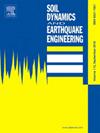根据实验室测试对南意大利细粒土的动态特性进行人工智能预测
IF 4.2
2区 工程技术
Q1 ENGINEERING, GEOLOGICAL
引用次数: 0
摘要
本研究以详细的实验室调查为基础,介绍了使用人工智能(AI)预测南意大利细粒土动态行为的方法。调查包括共振柱 (RC)、循环扭转剪切 (CTS) 和循环三轴 (CTx) 测试,测试对象是从西西里岛(南意大利)的 11 个地点取回的 25 个细粒土试样。为了建立对场地响应分析和土壤与结构动态相互作用至关重要的土壤动态特性的精确预测模型,采用了各种回归技术。这些技术包括从多元线性回归(MLR)到更复杂的人工智能方法,特别是基于前馈神经网络(FFN)的机器学习(ML)和深度学习(DL)。我们开发了三种预测模型,利用剪切应变 (γ)、塑性指数 (PI)、约束压力 (p'0) 和过固结比 (OCR) 这四项输入,得出随应变变化的剪切模量 (G)、阻尼比 (D) 和归一化剪切模量 (G/G0)。为确定最佳 FFN 拓扑,通过改变隐藏层(1-3 层)、隐藏神经元(每层 1-50 个)和激活函数(ReLU、sigmoid 和双曲正切)开发了 1350 个网络。此外,还研究了通过遗传算法和粒子群优化技术优化的混合 FFN。少于 15 个神经元的单隐层网络提供了可接受的预测结果(G-γ 模型的 R2test 为 0.97,G/G0-γ 模型的 R2test 为 0.93,D-γ 模型的 R2test 为 0.85)。多隐藏层网络为 G 和 D 模型提供了更高的准确度,但在实际应用中更为复杂。FFN 模型的性能优于 MLR 和其他既定的经验公式,这突出表明后者的建模参数具有地点特异性。本文章由计算机程序翻译,如有差异,请以英文原文为准。
AI-driven predictions of the dynamic properties of fine-grained soils in South Italy based on laboratory testing
This study presents the use of Artificial Intelligence (AI) to predict the dynamic behaviour of fine-grained soils of South Italy based on a detailed laboratory investigation. The investigation consists of Resonant Column (RC), Cyclic Torsional Shear (CTS), and Cyclic Triaxial (CTx) tests performed on 25 specimens of fine-grained soils retrieved from 11 sites in Sicily (South Italy). To develop accurate predictive models of soil dynamic properties, essential for site response analyses and dynamic soil-structure interaction, various regression techniques were applied. These techniques range from Multiple Linear Regression (MLR) to more complex AI methods, specifically Machine Learning (ML) and Deep Learning (DL) based on FeedForward Neural networks (FFN). Three predictive models were developed to derive strain-dependent shear modulus (G), damping ratio (D), and normalized shear modulus (G/G0), using four inputs: shear strain (γ), plasticity index (PI), confining pressure (p’0), and the Over Consolidation Ratio (OCR). To determine the optimal FFN topology, 1350 networks were developed by varying hidden layers (1–3), hidden neurons (1–50 per layer), and activation functions (ReLU, sigmoid and hyperbolic tangent). Hybrid FFN optimised through Genetic Algorithm and Particle Swarm Optimization techniques were also investigated. Single-hidden layer networks with fewer than 15 neurons provided acceptable predictions (R2test of 0.97 for G-γ, 0.93 for G/G0-γ, and 0.85 for D-γ models). Multiple-hidden layer networks yielded higher accuracy for G and D models but are more complex for practical use. The FFN models outperformed MLR and other established empirical formulations, highlighting the site-specificity of the modelling parameters of the latter.
求助全文
通过发布文献求助,成功后即可免费获取论文全文。
去求助
来源期刊

Soil Dynamics and Earthquake Engineering
工程技术-地球科学综合
CiteScore
7.50
自引率
15.00%
发文量
446
审稿时长
8 months
期刊介绍:
The journal aims to encourage and enhance the role of mechanics and other disciplines as they relate to earthquake engineering by providing opportunities for the publication of the work of applied mathematicians, engineers and other applied scientists involved in solving problems closely related to the field of earthquake engineering and geotechnical earthquake engineering.
Emphasis is placed on new concepts and techniques, but case histories will also be published if they enhance the presentation and understanding of new technical concepts.
 求助内容:
求助内容: 应助结果提醒方式:
应助结果提醒方式:


